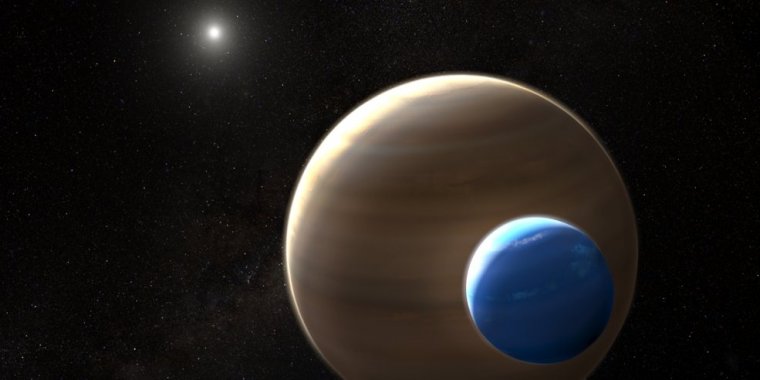| News / Space News |
Astronomers Find First Evidence of Possible Moon Outside Our Solar System
Using NASA’s Hubble and Kepler space telescopes, astronomers have uncovered tantalizing evidence of what could be the first discovery of a moon orbiting a planet outside our solar system.

NASA’s Hubble and Kepler space telescopes have uncovered what could be the first moon outside our solar system ever found. Credits: NASA/ESA/L. Hustak
This moon candidate, which is 8,000 light-years from Earth in the Cygnus constellation, orbits a gas-giant planet that, in turn, orbits a star called Kepler-1625. Researchers caution that the moon hypothesis is tentative and must be confirmed by follow-up Hubble observations.
Since moons outside our solar system – known as exomoons – cannot be imaged directly, their presence is inferred when they pass in front of a star, momentarily dimming its light. Such an event is called a transit, and has been used to detect many of the exoplanets cataloged to date.
However, exomoons are harder to detect than exoplanets because they are smaller than their companion planet, and so their transit signal is weaker when plotted on a light curve that measures the duration of the planet crossing and the amount of momentary dimming. Exomoons also shift position with each transit because the moon is orbiting the planet.
Scientists monitored the planet before and during its 19-hour transit across the face of the star. After the transit ended, Hubble detected a second, and much smaller, decrease in the star’s brightness approximately 3.5 hours later. This small decrease is consistent with a gravitationally-bound moon trailing the planet, much like a dog following after its owner.
In addition to this dip in light, Hubble provided supporting evidence for the moon hypothesis by finding the planet transit occurring more than an hour earlier than predicted.
This is consistent with a planet and moon orbiting a common center of gravity that would cause the planet to wobble from its predicted location, much the way Earth wobbles as our Moon orbits it.
The researchers note the planetary wobble could be caused by the gravitational pull of a hypothetical second planet in the system, rather than a moon. While Kepler has not detected a second planet in the system, it could be that the planet is there, but not detectable using Kepler’s techniques.
The scientists report the candidate moon is unusually large – potentially comparable to Neptune. Such large moons do not exist in our own solar system. The researchers say this may yield new insights into the development of planetary systems and may cause experts to revisit theories of how moons form around planets.
The moon candidate is estimated to be only 1.5 percent the mass of its companion planet, and the planet is estimated to be several times the mass of Jupiter. This mass-ratio is similar to the one between Earth and the Moon.
In the case of the Earth-Moon system and the Pluto-Charon system, the moons are thought to be created through dust leftover after rocky planetary collisions. However, Kepler-1625b and its possible satellite are gaseous and not rocky, so the moon may have formed through a different process. (NASA)
YOU MAY ALSO LIKE


